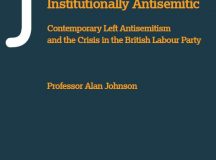David Feldman and others have argued against the adoption of the IHRA definition of antisemitism by universities on the grounds that the 2010 Equality Act and university harassment codes render it redundant. This is to seriously misunderstand the 2010 Equality Act. The Act itself offers no guidance as to what constitutes antisemitism, so it is necessary to look for guidance outside it. The same consideration applies to university anti-harassment codes. The case for the necessity of the IHRA is put by Lesley Klaff, a senior lecturer in law at Sheffield Hallam University and Editor-in-Chief of the Journal of Contemporary Antisemitism, and Derek Spitz, a barrister at One Essex Court Chambers who acted for the Campaign Against Antisemitism in the Equality and Human Rights Commission’s Investigation into Antisemitism in the Labour Party.
INTRODUCTION
The CST report Campus Antisemitism in Britain 2018-2020, published in December 2020, revealed a significant rise in antisemitic incidents affecting Jewish students, student societies and lecturers in the past two academic years, with the total number of incidents for 2019-20 being the highest CST has ever recorded. This was despite the academic year having been cut short by the COVID-19 pandemic. It is because of this increase in campus antisemitism, and the reported failure of universities to recognise antisemitism in their institutions because of incomplete or inappropriate definitions, or even no definition at all, that the Secretary of State for Education, Gavin Williamson, wrote to all vice-chancellors in October 2020 imploring them to sign up to the IHRA Working Definition of Antisemitism by the end of the year. In doing so, the Secretary of State was supported by the Government’s Independent Advisor on Antisemitism, Lord John Mann, the Shadow Education Minister, Kate Green, Britain’s Jewish communal bodies, and the Union of Jewish Students.
The response of British universities has so far been underwhelming. At the time of writing (mid-January 2021), only 48, among them Cambridge, Oxford and UCL, have adopted the working definition out of 130. This is because there has been considerable pushback against IHRA’s adoption by some academics and some student societies on various grounds, including the often repeated and incorrect claim that the IHRA definition is a threat to free speech and academic freedom on campus.
Another line of argument against the adoption of the IHRA working definition by universities has emerged since the publication on 29 October 2020, of the report of the investigation by the Equality and Human Rights Commission (the Commission) into antisemitism in the Labour Party. This line of argument, which has been advanced by Yair Wallach of SOAS, David Feldman of the Pears Institute, and Seth Anziska of University College London, is misinformed. It claims that the damning findings of the EHRC Report about antisemitism in the Labour Party illustrate that the Equality Act 2010 (henceforth ‘the 2010 Act’) can be used to combat antisemitism in universities, making the IHRA definition redundant; and that in fact the use of the 2010 Act is far preferable to the use of the IHRA definition for this purpose because it safeguards all minority groups from discrimination, and therefore places the struggle against antisemitism within the broader context of the struggle against all racisms.
The argument asserts that adopting the IHRA definition will not address structural racism in universities but will ‘privilege one group over others by giving them additional protections and in so doing will divide minorities against each other.’ This is not well founded. There is no reason why the recognition of difference entailed in formulating a definition of the particular form of discrimination under challenge should amount to privileging one group over others. In fact, the universities’ ability to recognise and respond to complaints of antisemitism will help them to discharge their Public Sector Equality Duty under the 2010 Act. Section 149 provides that universities must have due regard to the need to eliminate unlawful discrimination, harassment and victimisation, and other conduct prohibited by the Act; advance equality of educational opportunity between students of different racial, ethnic and religious groups; and foster good relations between students of different racial, ethnic and religious groups, including by tackling prejudice and promoting understanding.
The argument against adoption relies on an anti-racist universalism to argue against the use of the IHRA definition by universities. The argument is based on a misunderstanding of the 2010 Act, and a misreading of the EHRC Report. We deal with each of these below.
THE 2010 ACT IS NOT A SUBSTITUTE FOR THE IHRA DEFINITION. BOTH ARE NEEDED
One of the key findings of the EHRC Report was that the Labour Party had, through the acts of its agents, breached the 2010 Act, by committing unlawful harassment of its members related to race (Jewish ethnicity). ‘Harassment’, under the 2010 Act, means treating someone in a way related to a protected characteristic that violates their dignity or creates a hostile, degrading, humiliating or offensive environment. The Commission found that the antisemitic conduct of two of the Labour Party’s agents amounted to unlawful harassment of its Jewish members.
The Commission stated that to identify these unlawful acts as ‘harassment’, it had been necessary to apply the definitions contained in the 2010 Act and noted that the IHRA definition is not legally binding. This has been interpreted by some opponents of the IHRA definition as evidence, if not proof, that the 2010 Act can be used to tackle antisemitism in universities under the rubric of harassment without the need for the IHRA definition. Wallach wrote: ‘The legal foundation for the report is the 2010 Equality Act, which is general in its applicability to groups of protected characteristics (such as race and religion). The basis here is equality and the universal protection against racial discrimination and harassment. Furthermore, the report does not rely on the IHRA definition, which it states clearly is not legally binding. The Commission reached its damning verdict the (sic) based on general applicability of the 2010 Equality Act.’ David Feldman, for his part, wrote that, ‘The damning verdict of the EHRC’s recent report on the Labour Party provided a clear demonstration that the universalist principles gathered in the Equality Act can be used to hold powerful institutions to account’ and noted that ‘Universities operate under the Equality Act; they also have internal policies and procedures designed to address discrimination, harassment and victimisation.’ He added that ‘Jewish staff and students deserve protection, but imposing the working definition will not secure it.’
This line of argument that campus antisemitism can be fully addressed under the rubric of harassment using the 2010 Act overlooks the fact that before speech or conduct can be found to constitute ‘harassment’ on a protected ground, it is essential to know what that speech or conduct is, and why it is harassing. This requires a definition. The need stems from the wording of the relevant statutory section on ‘harassment’ itself. Section 26(1)(a) of the 2010 Act defines ‘harassment’ as ‘unwanted conduct related to a relevant protected characteristic’ [emphasis added]. The relevant protected characteristics include age, disability, gender reassignment, race, religion or belief, sex, and sexual orientation. Harassment itself is not made unlawful under section 26. It is only where the harassment is related to a particular protected characteristic that it becomes unlawful. There must be a sufficiently close connection between the act complained of and the protected characteristic. In the case of Jewish people, it is the ability to define the conduct complained of as antisemitic that provides the sufficiently close connection between the unwanted conduct and the protected characteristic. In the case of a different protected group, such as homosexuals, a definition or some other way of recognising homophobia would be necessary.
Jews are protected under section 26 of the 2010 Act on the basis of ‘race’ (Jewish ethnicity) and ‘religion or belief’. In the case of alleged harassment based on Jewish ethnicity, the necessary assessments cannot be made without the ability to recognise antisemitic conduct and to understand why that conduct would be likely to harass someone who identifies as Jewish. Nothing in the 2010 Act or in the Commission’s application of the legislation dispenses with this need to know what antisemitism is. Yet nothing in the 2010 Act provides the necessary definition. The Commission quite understandably applied the statutory definition of ‘harassment’ without reference to IHRA. It would have been odd if it had done anything else. However, the ‘unwanted conduct’ it identified is not defined within the four corners of the legislation. The important point is that where harassment of Jewish people is concerned, the unwanted conduct is unwanted precisely because it is antisemitic conduct. The Commission recognised as much.
To qualify as ‘harassment’ the conduct must, under section 26(1)(b), ‘violate the victim’s dignity or create an intimidating, hostile, degrading, humiliating or offensive environment’ for her. In deciding whether the conduct has had that effect, the decision-maker must take into account the victim’s perception under section 26(4)(a). This is a subjective test. The decision-maker must also take into account the other circumstances of the case and whether it is reasonable for the conduct to have that effect under sections 26(4)(b) & (c). This is an objective test.
In making this determination, the decision-maker must consider the implications of various rights, such as freedom of expression, as set out in Article 10 of the European Convention of Human Rights (ECHR). This is because, where possible, the 2010 Act must be read and applied in a way that is compatible with the ECHR, which was brought directly into UK law by the Human Rights Act 1998. Conduct should not be regarded as harassment, and no action should be taken on it, where this would breach the Article 10 rights of the person whose conduct is in issue, or of the organisation that is responsible for their actions. This will often require a delicate balancing of rights to be undertaken involving the legal concept of ‘proportionality’. It is important to note that the unlawful harassment section of the 2010 Act, like the highly context-sensitive IHRA definition and examples, needs to be sensitively understood and carefully applied. Context is critical in defining ‘harassment’ just as it is in defining ‘unwanted conduct’ as antisemitic: the need to exercise judgment cannot be avoided in either case.
It is particularly important to understand the difference between expression that is antisemitic and expression that is merely offensive. Expression that is ‘merely’ offensive, provocative, or insulting is protected under Article 10 ECHR as free speech and the 2010 Act will not ordinarily seek to regulate that speech where none of the protected grounds under the Act are engaged. On the other hand, expression that is racist and amounts to a form of hate speech is not protected by the ECHR. It is considered to be incompatible with society’s fundamental values of tolerance, social peace, and non-discrimination.
Racist expression has been found by the European Court of Human Rights to include antisemitic speech and conduct including Holocaust denial. And even where the speech, although antisemitic, nevertheless falls within the scope of the right to freedom of expression, it can still be restricted, as long as this is done in a proportionate manner. In short, ‘mere’ offense, provocation or insult is within the scope of the guarantee of free expression and will not generally engage the 2010 Act at all. Antisemitic speech, by contrast, will frequently fall outside the scope of the free speech guarantee altogether and no balancing of freedom of speech and equality rights will be required. But even where it does not fall outside the scope of the right altogether, antisemitic speech may still be regulated (through a balancing exercise), for example as ‘harassment’ under the 2010 Act.
In sum, the reason the Commission found that the Labour Party unlawfully harassed Jewish members in relation to their race (Jewish ethnicity) under the 2010 Act was not because the conduct complained of was ‘merely’ provocative, insulting or offensive. It was because the conduct complained of was antisemitic, which is the reason why it was related to a protected characteristic. The Commission was ‘satisfied that the antisemitic conduct had the effect of contributing to violating the dignity of a member … or contributing to creating an intimidating, hostile, degrading, humiliating or offensive environment…’ Indeed, the antisemitic conduct the Commission identified in its Report was so egregious that it fell outside the scope of Article 10 altogether (pp.29; 108; 110).
As there is no guidance as to what constitutes antisemitism in the 2010 Act itself, it is necessary to look for guidance outside it. This is why the 2010 Act cannot, and has not, made the IHRA working definition of antisemitism redundant. Moreover, in the application by universities of their anti-harassment codes, as these follow the law, the same need for a definition of antisemitism applies.
Two of the criticisms of the IHRA definition by those advocating the use of the EA 2010 to combat campus antisemitism are that, in the words of Feldman, first, IHRA is not a ‘precision instrument’ but a ‘niche widget’ and secondly, that its use will interfere with universities’ autonomy.
However, IHRA is not meant to be a ‘precision instrument’ as much as a heuristic device or working tool that assists in identifying antisemitism and educating people about it. It should be evident from what we have already said that the 2010 Act is not a ‘precision instrument’ either: it is a complex piece of legislation that was passed to codify the law by bringing together all existing anti-discrimination legislation. The application of section 26 requires a consideration of context and an ability to exercise judgment at least as much and probably more so than does the IHRA definition. But unlike the IHRA definition, the 2010 Act cannot readily be understood and applied by university administrators who have no legal knowledge or training. This means that the Section 26 anti-harassment provision could not be used effectively to combat campus antisemitism without engaging the machinery of the law. This, however, would be counter-productive for both the university and the complainant: the use of lawyers is prohibitively expensive for most students; the allegation of antisemitic harassment would be made public, thereby threatening the reputation of the university; and the autonomy of the university would be compromised as the case would be removed from the university’s internal procedures.
In short, the 2010 Act cannot operate without a definition of the conduct it condemns. The 2010 Act will regulate insults or provocations when they are related to a protected characteristic such as race (Jewish ethnicity), in other words, when they are antisemitic. Whether the insults and provocations are of that type requires a definition of antisemitism.
THE EQUALITY AND HUMAN RIGHTS COMMISSION REPORT INTO LABOUR ANTISEMITISM IS CONSISTENT WITH THE IHRA DEFINITION AND ATTUNED TO ISRAEL-RELATED ANTISEMITISM
As we have said, Wallach declares that ‘the report does not rely on the IHRA definition, which it states clearly, is not legally binding. The EHRC reached its damning verdict the (sic) based on general applicability of the 2010 Equality Act.’ This observation contains a little truth and a larger obfuscation. The regulator, upon whom statutory powers are conferred under the Equality Act 2006 to make findings of unlawful conduct under the 2010 Act will obviously do so by applying that legislation. The very nature and purpose of the investigation was to determine whether the Labour Party had breached the 2010 Act, which is why the whole report is framed around the EA 2010. The fact that the Commission was able to determine, by applying the 2010 Act, that the Labour Party had committed unlawful ‘harassment’ of its Jewish members should come as no surprise. To that extent Wallach’s observation that it did so is true, but it is trivially true. However, the observation incorrectly implies either that the 2010 Act itself provides a definition of antisemitism or that the need for a definition has been rendered unnecessary. That is an obfuscation. Although the definition does not come from the 2010 Act, the Act cannot function without one.
It was not necessary for the Commission to rely specifically on the IHRA definition of antisemitism to decide whether the Labour Party breached the Act, although it could have done so. It was unnecessary because the Commission was able to rely on the extensive guidance, analysis and materials provided by Professor Alan Johnson in his 21 March 2019 report, Institutionally Antisemitic: Contemporary Left Antisemitism and the Crisis in the British Labour Party as well as on evidence and submissions by the complainants, the Campaign Against Antisemitism and the Jewish Labour Movement concerning the nature of antisemitism, together with mountains of examples. As the Commission noted, what it focused on ‘represents the tip of the iceberg’. This does not make the IHRA definition irrelevant. The Commission states on page 26 of the Report that its findings are consistent with IHRA; on page 125 that it ‘may have regard to the IHRA’s working definition of antisemitism and associated examples…’; and on page 116 that the unwanted conduct meets the definition of ‘harassment’ and would also meet the IHRA definition and examples.
The Commission’s discussion of the range and volume of antisemitic conduct across the complaint sample provides clear cut examples of antisemitism under the IHRA definition. On page 31 of the Report it records that it found evidence of ‘antisemitic conduct’ relating to social media comments that: ‘diminished the significance of the Holocaust; expressed support for Hitler or the Nazis, compared Israelis to Hitler or the Nazis; described a “witch hunt” in the Labour Party or said that complaints had been manufactured by the “Israel lobby”; referenced conspiracies about the Rothschilds and Jewish power and control over financial or other institutions; blamed Jewish people for the “antisemitism crisis” in the Labour Party; blamed Jewish people generally for the actions of the state of Israel; used “Zio” as an antisemitic term, and accused British Jews of greater loyalty to Israel than Britain.’ None of these examples of antisemitism derive from or are defined in the 2010 Act and yet the Commission did not hesitate in calling them by their proper name.
Similarly, Wallach is wrong to declare that ‘The ECHR Report sends a strong message. It illustrates that it is possible to tackle antisemitism without conflating it with criticism of Israel.’ The suggestion that IHRA is responsible for such alleged conflation is a frequently repeated charge. It remains untroubled either by the express stipulation to the contrary in the text of IHRA itself or by the dearth of evidence of such conflation. In any event, there are several references to Israel-critical speech in the Report which make the same distinction that IHRA does. For example, on page 27 the Commission states that ‘Art. 10 [ECHR] will protect Labour Party members who, for example, make legitimate criticism of the Israeli government…it does not protect criticism of Israel that is antisemitic’ and it adds in a footnote that ‘where we refer to legitimate criticism of Israel throughout the Report, we mean that criticism that is not antisemitic.’
While much criticism of Israel will not be antisemitic, some is and will be. The concepts do not operate in hermetically sealed containers, as the Commission expressly recognises. On pages 29 and 30 of the Report, the Commission discusses the 2015 incident involving Israel-related antisemitism of Naz Shah and Ken Livingstone’s support for her comments. The Commission found that Ken Livingstone’s conduct was Israel-related antisemitism that did not warrant any protection at all under the right to freedom of speech. Moreover, the Commission’s discussion of the antisemitism that occurred on social media frequently, involves examples relating to the Israel/Palestinian conflict.
The Commission’s discussion of the Macpherson Principle, by which all complaints of racism should, in the first instance, be recorded and investigated as such when they are perceived by the complainant, or a third party, as an act of racism, is consistent with the Commission’s recognition that antisemitism is often an Israel-related phenomenon. This is because taking the point of view of the complainant as the starting point allows for the possibility that an attack on Israel could amount to the unlawful harassment of Jews. In addition, the Commission found that responding to complaints of antisemitism by labelling them as fake or smears was a denial of antisemitism, which constituted unlawful harassment of Jewish members. This denialist narrative, increasingly well-known now as the Livingstone Formulation, is frequently related to Israel and is itself now a contemporary antisemitic trope. What the Commission actually did contradicts Wallach’s claim that in the two central complaints, the Commission simply highlighted ‘classic antisemitic tropes.’
CONCLUSION
In conclusion, the claim that the EHRC Report is proof that the 2010 Equality Act, rather than the IHRA definition, ought to be used by universities to tackle campus antisemitism, is seriously misguided. The EHRC Report made findings of unlawful harassment precisely because the ‘unwanted conduct’ in question was antisemitic. That unwanted conduct did not qualify for even a minimal level of free speech protection. It was so egregiously antisemitic that it fell outside the ambit of Article 10 altogether. The 2010 Act contains no definition of antisemitism but the approach the Commission adopted to identifying antisemitism is consistent with IHRA and its examples. The EHRC Report provides no warrant whatsoever for dispensing with the IHRA definition.
Antisemitism in universities can only be tackled by establishing appropriate procedures within those institutions, and by encouraging students to report and challenge antisemitism where it exists, as recommended by the Community Security Trust in its December 2020 report. To do this, it is vital to have available an adequate and accepted working definition of antisemitism, such as the IHRA definition.





































